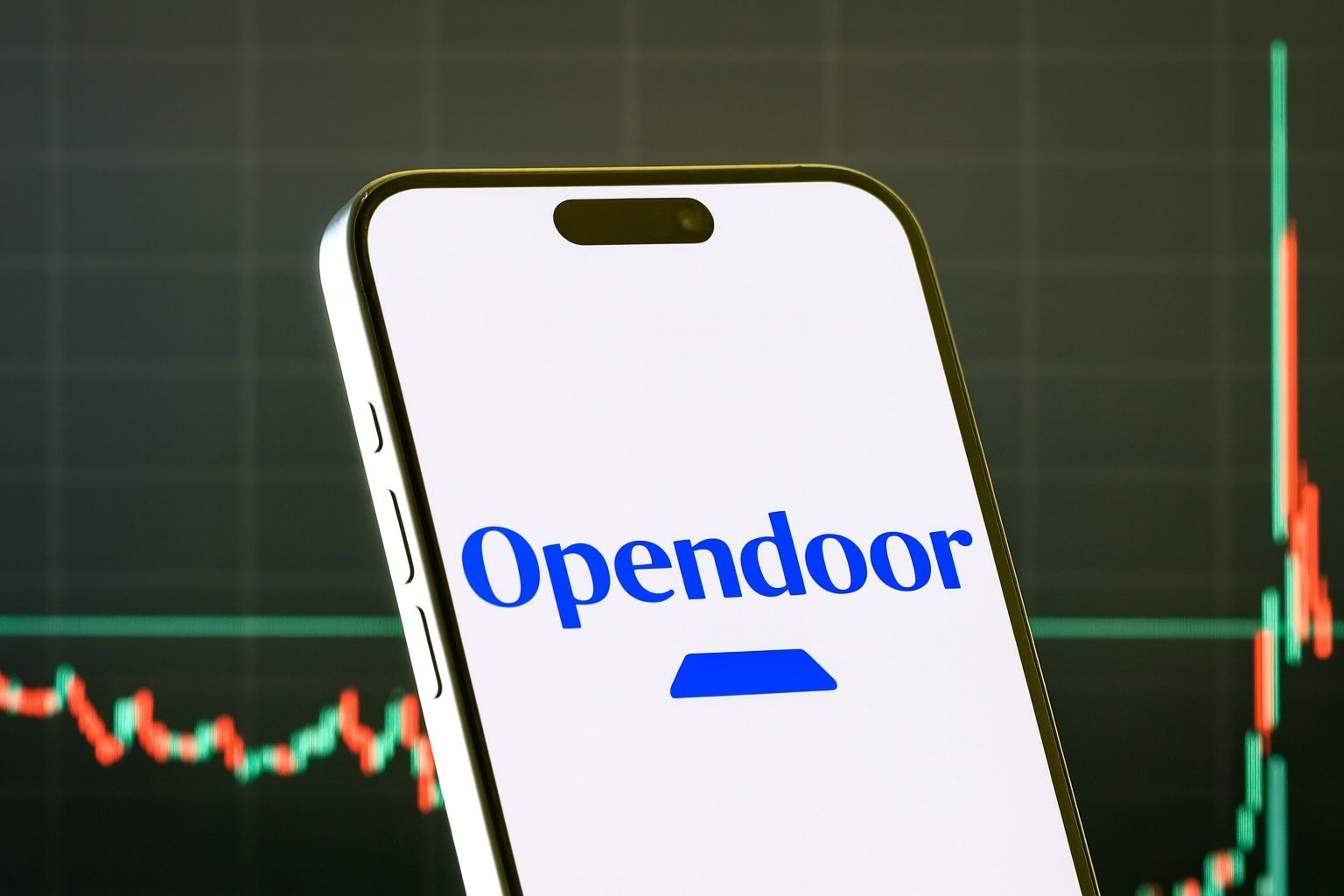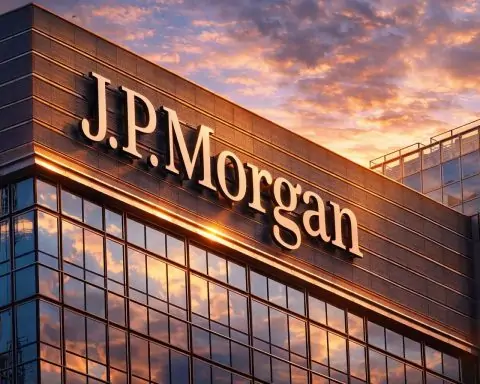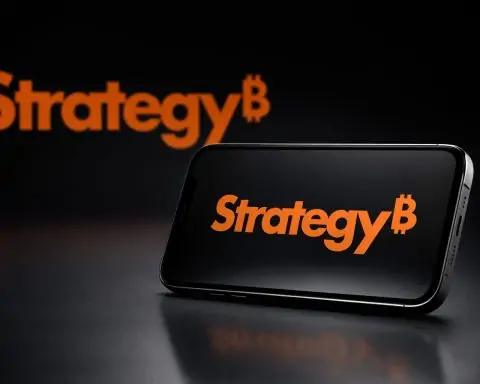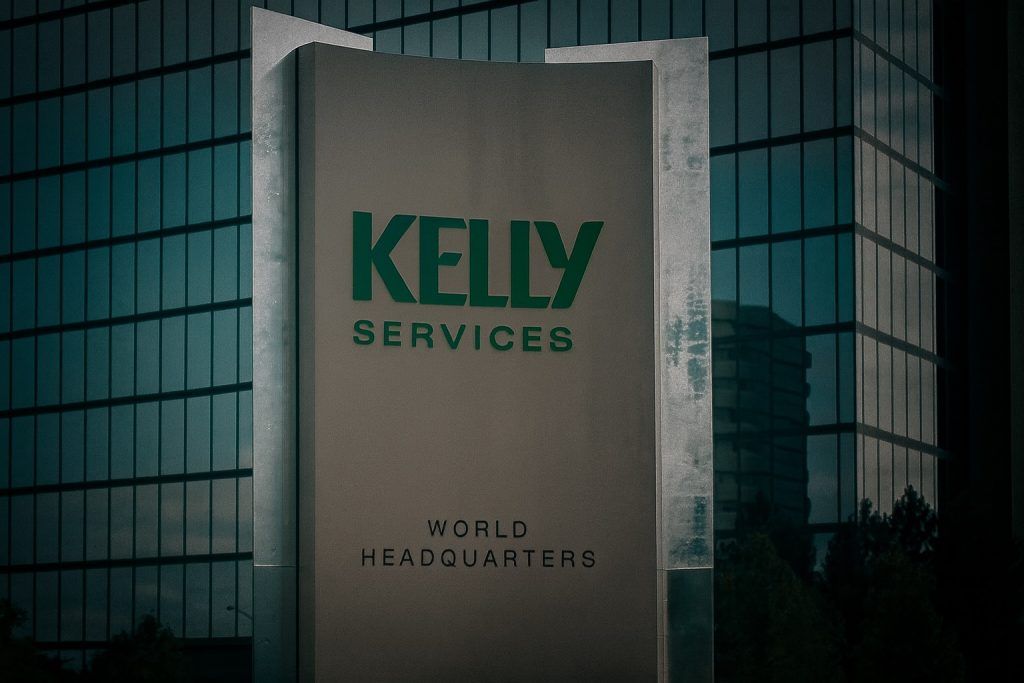- Current price/trends: As of Oct. 15, 2025 (midday), OPEN trades around $7.7 on the Nasdaq [1] [2]. That’s up about +1.6% on the day and roughly flat to slightly higher than a week ago. However, the stock has been extremely volatile – it climbed from roughly $0.50 in June 2025 to over $10 in mid-September, a ~1,600% surge on retail investor frenzy [3], before retracing into the $7–$8 range (see chart below [4]).
- Year-to-date gains: OPEN is now up hundreds of percent YTD – vastly outperforming the S&P 500 – thanks to the meme-fueled rally. (Yahoo Finance notes a ~+369% YTD return for OPEN vs ~+14% for the S&P [5].)
- Q2 2025 results: The company reported $1.6 billion in Q2’25 revenue (up slightly from a year ago), with a gross profit of $128M [6]. Crucially, Opendoor posted about +$23M adjusted EBITDA in Q2 (its first positive quarter on that basis since 2022) [7]. Net loss narrowed to $29M [8], as the company sold 4,299 homes (up 5% YoY) while aggressively cutting inventory to $1.5B (4,538 homes) [9].
- Outlook: Management cautioned that Q3 will be much softer: guidance calls for $800–$875M revenue and a net loss (Adj. EBITDA of –$28M to –$21M) [10]. This sequential drop reflects higher mortgage rates and slower home sales.
- Leadership shakeup: In September, long-time CEO Carrie Wheeler stepped down and Shopify’s COO Kaz Nejatian was tapped as the new CEO [11]. Co-founders Keith Rabois (now Chairman) and Eric Wu returned to the board to “inject the founder DNA” [12] [13]. Rabois praised Nejatian as “the right leader to unlock Opendoor’s unique data and assets” and drive AI-based innovation [14]. Nejatian himself said it’s “a privilege” to lead Opendoor, and with AI the company has tools to make the home‑buying experience “radically simpler, faster, and more certain” [15].
- New funding: Along with the leadership change, Opendoor announced a $40 million PIPE (private equity) investment from Khosla Ventures (Rabois’s firm) and Eric Wu [16]. This cash infusion is earmarked for Opendoor’s turnaround and growth plans.
- Buyer incentives: In early Oct 2025, Opendoor rolled out new buyer perks – a 100‑day warranty on major home systems/appliances and a novel “7-Day Home Test Drive” allowing buyers to move in early and back out if unsatisfied [17]. These steps (starting in Dallas and to be nationwide) aim to boost home sales in a competitive housing market.
- Market sentiment: The meme-stock crowd remains a big force. Retail traders (the “$OPEN Army”) have piled in, generating daily volumes in the hundreds of millions. As 247WallStreet noted, Jackson’s July endorsement (“next Carvana”) triggered a massive rally, but by late Sept “the honeymoon’s over” as traders fled OPEN for a new fad [18]. Opendoor’s stock plunged ~12% on Sept. 22 (and another ~8% in early Sept. 23) when hype shifted to another company [19]. “Market commentators warn that such hype-driven gains are ‘a sugar rush, not sustenance,’ likely to fade once the buzz moves on,” one analyst commented [20].
- Analyst outlook: Traditional Wall Street analysts are extremely cautious. Benzinga reports a consensus “Hold” with an average 12-month target of only ~$2.36 [21]. Recent targets range roughly $0.70–$1.60 (Citigroup ~$0.70 [22], KBW ~$1.00 [23], UBS ~$1.60 [24]). By contrast, momentum bulls like Eric Jackson have talked in the high tens of dollars [25]. Noted commentator Matt Frankel (Motley Fool) warned on Oct. 9: “Opendoor’s stock performance [has been] strong… but it’s starting to remind me of the 2021 meme stock craze, and not in a good way” [26].
- Industry context: Opendoor’s fortunes hinge on the housing market. Mortgage rates have eased recently (Fed cut Sept 2025) [27] and new‑home sales surged +20.5% in August (see Benzinga) [28]. That report lifted OPEN ~10% on Sept. 24 [29], as bullish investors bet a stronger housing market will boost Opendoor’s flip margins. Still, home-flipping gross margins remain thin (~8%), and volume depends on interest rates.
Stock Price & Performance: Opendoor stock has been on a roller-coaster. After languishing under $1 in June 2025 (even risking Nasdaq delisting), OPEN exploded in July–Sept on social‑media mania. By Sept. 11, the stock leapt ~79% in one day when the CEO shakeup was announced [30]. From roughly $0.53 in late June it topped $10 mid-September [31] (a ~1,600% run). Since then it has corrected into the $7–$8 range, trading around $7.7 on Oct. 15 [32] [33]. (For comparison, the S&P 500 is up ~15% YTD.) The week-to-week swings have been dramatic – intraday volume often reaches hundreds of millions of shares, far above historical norms [34] [35].
Opendoor (OPEN) intraday price action in October 2025 (source: Investing.com) [36].
Financial Results: Despite the hype, the underlying business is only just recovering. In Q2 2025 (ended June 30), Opendoor reported $1.6B revenue (about flat YoY) and $128M gross profit [37]. It sold 4,299 homes (up 5%), but inventory purchases remain low (only 1,757 homes bought in Q2, 63% below year‑ago) [38]. Importantly, Opendoor squeezed out $23M of positive adjusted EBITDA in Q2 [39] – its first profitable quarter since 2022 – by cutting costs and improving operations. Management emphasized this progress: CEO Carrie Wheeler said “we delivered $1.6 billion in revenue in the second quarter and achieved our first quarter of Adjusted EBITDA profitability since 2022…” [40]. Net loss narrowed to $29M [41].
However, Opendoor sees a pullback ahead. It now guides for 3Q revenue of $800–875M and an adjusted EBITDA loss of $21–28M [42]. That sharp sequential drop (down roughly 45%) reflects ongoing housing market headwinds and higher mortgage costs. CFO Selim Freiha noted that moving forward Opendoor will also shift toward an “agent-led” model to generate more capital-light revenue streams [43], partly to offset the lumpy home-flip business.
Leadership & Strategy: September’s leadership overhaul surprised many. Longtime CEO Carrie Wheeler (who took over in 2022) stepped down effective Sept. 10, and Kaz Nejatian – the COO of Shopify – was named Opendoor’s new CEO [44]. Co-founders Keith Rabois and Eric Wu returned to the board (Rabois as Chairman) at the same time [45]. Rabois praised Nejatian as “decisive” and “the right leader to unlock Opendoor’s unique data and assets as we build on Opendoor’s original mission” [46]. In the press release, Nejatian said he was “privileged” to lead Opendoor and sees AI as key: “With AI, we have the tools to make [home buying] radically simpler, faster, and more certain” [47].
Rabois has also been candid about the firm’s challenges. He publicly called Opendoor “bloated” with ~1,400 employees and plans an extreme downsizing – possibly to around 200 staff (an ~85% cut) [48] – to streamline operations. To support the turnaround, Rabois’s firm Khosla Ventures and Wu committed $40M in new equity (via a private placement) [49]. The $40M injection is intended to fund growth initiatives and cushion the business while housing conditions remain uneven.
On the product side, Opendoor is leaning into its tech platform. In early October the company launched “Opendoor Peace of Mind” buyer features (announced Oct. 1). Every Opendoor-listed home now comes with a 100-day warranty on major systems/appliances, and buyers get a 7-day Home Test Drive: move in up to 7 days early and exit before closing if they’re unhappy [50]. These consumer-friendly moves (starting in Dallas, rolling out nationwide) are meant to stimulate demand by reducing buyer risk.
Market & Industry Context: Opendoor’s fate is tied to the broader housing market. Recently there have been mixed signals. After years of high rates, the Fed cut rates in mid-September 2025 to 4.00–4.25%, helping push the average 30-year mortgage down to ~6.4% [51] (the lowest in a year). Housing data also surprised to the upside: U.S. August new-home sales jumped +20.5% MoM (to an 800,000 annualized rate) [52], and median new-home prices hit $413,500 [53]. For Opendoor, better home sales and rising prices are good news, since it profits by flipping homes. Indeed, on Sept. 24 (following the new-home sales report) OPEN’s stock rallied ~10% [54], recouping much of that week’s earlier losses.
Still, housing demand remains sensitive to rates and affordability. Opendoor’s gross margin is thin (around 8%), and with rising costs or a slowdown in buyers, profitability could slip back into the red (as Q3 guidance reflects). The industry is also getting more competition: Zillow Offers and RedfinNow still exist (though scaled back), and many brokerages are testing iBuyer models. In this environment, operational discipline and capital efficiency (the focus of Rabois’s overhaul) will be crucial.
Meme Mania vs. Fundamentals: One of Opendoor’s biggest quirks in 2025 is its “meme stock” status. On social media, retail traders have been obsessively trading OPEN, often detached from fundamentals. Short interest is still high (~26% of float), setting the stage for squeezes. Trading volume exploded – at times surpassing the company’s entire float – as the “$OPEN Army” swapped memes and market tips [55]. Eric Jackson’s tweets (“the next Carvana”) lit the initial fire. But this crowd is fickle. When Jackson later championed another mortgage fintech (“Better Homes & Finance”), OPEN shares tumbled over 12% on Sept. 22 as traders rotated out [56]. Market veterans are skeptical: one commentator quipped that Opendoor’s gains are “a sugar rush, not sustenance” [57]. The wild swings underscore that OPEN’s short-term trading is now as much about sentiment as underlying results.
Analyst Views & Outlook: Sentiment among professional analysts remains dour. Most Wall Street firms rate OPEN a Hold or Sell. Capital.com notes price targets mostly in the $0.70–$1.60 range [58] [59], reflecting doubt about near-term growth. Benzinga reports a consensus Hold from 15 analysts and an average 12-month target of only ~$2.36 [60]. Citigroup cut its target to $0.70 (Sell) [61], KBW’s target is $1.00 (Hold) [62], and UBS recently raised its neutral target to just $1.60 [63]. Even bearish on Wall Street call Citigroup’s pro forma valuation (Implied $82/share) “highly aggressive” for a model with thin margins [64]. These low targets underline that most analysts see OPEN as far overvalued unless housing dramatically improves.
On the bullish side, algorithmic forecasters (CoinCodex models via Benzinga) predict OPEN will trade in the $9–$10 range by year-end 2025 [65] – essentially expecting prices to hold near recent levels. Benzinga’s “Bull Case” notes that a leaner, AI-driven Opendoor (with Rabois/Wu in charge) could see much higher profit margins and growth, especially if it partners broadly with real estate brokers and shifts to more software-like services [66]. And the large stake by Jane Street (a major quant trading firm) – which disclosed roughly a 5.9% position in mid-October [67] – adds fuel to the upbeat thesis by signaling some institutional confidence (the stock jumped ~10% in response).
Conclusion: Opendoor’s stock is at a crossroads. On one hand, the core business shows signs of stabilization (rising revenues and a return to EBITDA profitability in Q2). Leadership is taking bold (some say drastic) action to streamline and leverage technology. On the other hand, the recent stock rally has been largely sentiment-driven, and traditional metrics still look shaky. As one MarketBeat analyst put it: “the stock’s recent surge was largely driven by speculative trading… and can lead to a sudden and sharp decline, exposing investors to significant risk if sentiment shifts” [68]. In short, Opendoor’s 2025 journey reflects both the upside of a housing rebound and the downside of meme-driven volatility. Long-term investors will be watching the company’s actual financial turnaround and housing market conditions to see if the rally can be sustained beyond the hype.
Sources: Opendoor investor releases [69] [70]; stock price data [71] [72]; Benzinga [73]; Nasdaq, 247WallStreet, Motley Fool, ts2.tech [74] [75] [76]; industry news (Benzinga, Nasdaq reports) [77] [78] [79].
References
1. stockanalysis.com, 2. www.investing.com, 3. ts2.tech, 4. www.investing.com, 5. finance.yahoo.com, 6. www.globenewswire.com, 7. www.globenewswire.com, 8. www.globenewswire.com, 9. www.globenewswire.com, 10. www.globenewswire.com, 11. www.sec.gov, 12. www.sec.gov, 13. www.sec.gov, 14. www.sec.gov, 15. www.sec.gov, 16. www.sec.gov, 17. www.opendoor.com, 18. 247wallst.com, 19. 247wallst.com, 20. ts2.tech, 21. www.benzinga.com, 22. capital.com, 23. capital.com, 24. capital.com, 25. ts2.tech, 26. www.nasdaq.com, 27. capital.com, 28. ts2.tech, 29. ts2.tech, 30. ts2.tech, 31. ts2.tech, 32. stockanalysis.com, 33. www.investing.com, 34. ts2.tech, 35. ts2.tech, 36. www.investing.com, 37. www.globenewswire.com, 38. www.globenewswire.com, 39. www.globenewswire.com, 40. www.globenewswire.com, 41. www.globenewswire.com, 42. www.globenewswire.com, 43. www.globenewswire.com, 44. www.sec.gov, 45. www.sec.gov, 46. www.sec.gov, 47. www.sec.gov, 48. ts2.tech, 49. www.sec.gov, 50. www.opendoor.com, 51. capital.com, 52. ts2.tech, 53. ts2.tech, 54. ts2.tech, 55. ts2.tech, 56. 247wallst.com, 57. ts2.tech, 58. capital.com, 59. capital.com, 60. www.benzinga.com, 61. capital.com, 62. capital.com, 63. capital.com, 64. ts2.tech, 65. www.benzinga.com, 66. www.benzinga.com, 67. stockstotrade.com, 68. www.benzinga.com, 69. www.globenewswire.com, 70. www.sec.gov, 71. stockanalysis.com, 72. www.investing.com, 73. www.benzinga.com, 74. 247wallst.com, 75. ts2.tech, 76. www.nasdaq.com, 77. ts2.tech, 78. www.opendoor.com, 79. stockstotrade.com







